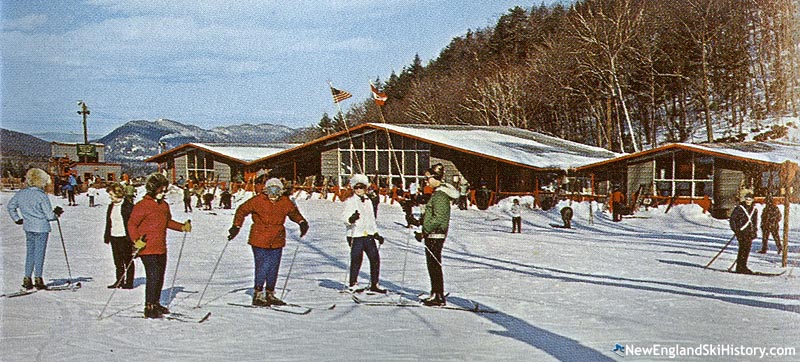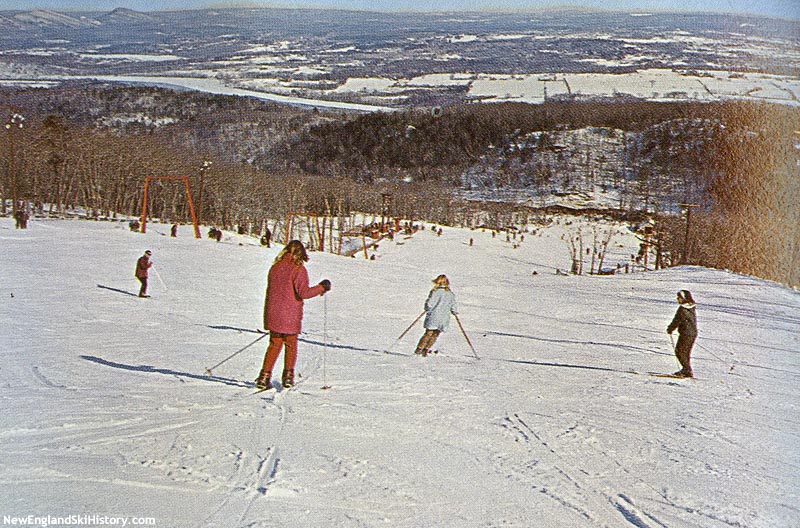The Resort That Time Forgot
Local East Coast ski area turned backcountry haven.
It was a bluebird afternoon, on a Sunday in late March of 2015. I found myself riding shotgun as my dad drove up a long winding road to the base of Mt. Tom in Holyoke, Massachusetts. Ski season on the East Coast was coming to an end, but it wasn’t going down without a fight as an unexpected snowstorm left behind a foot of the good stuff earlier that week. I had been itching to hit some of my local hike-to spots one last time that season, but my dad had a different plan in mind...Mt. Tom.

Mt. Tom Base Lodge circa 1960s. Photo courtesy of Jeremy Clark.
Mt. Tom, like many other local ski areas at the time, used to be a fully functioning ski resort complete with several base lodges, multiple chairlifts, and a jam-packed parking lot on the weekends. The last time my dad skied Mt. Tom was in 1998, the year the resort closed, this would be my first time. My dad often told stories of his fond memories at Mt. Tom with his junior high ski club, saying, “Hundreds of school-age kids would be bused up to the slopes after school. My group would all wait for each other at the top and ski down in a pack.” Looking at my current surroundings this image was pretty hard for me to believe. The main lodge was in rough shape and covered in graffiti, and the only remains of the four double-chairlifts were a couple of scattered operation huts at the top of the mountain.
Sadly, with the turn of the millennium came the consolidation and closing of many small, hometown ski areas. Founder of New England Lost Ski Areas Project, Jeremy Davis says, “There are many reasons for the loss of so many places—competition and consolidation, lack of capital investment, wildly variable winters, land redevelopment, high operating costs, volunteer apathy, the energy crisis in the 1970s, and more.” Being one of these unfortunate mountains, Mt. Tom was fated to become Mt. Tom State Reservation after its ownership changed several times and its land consequently broken up and sold to different owners. Regardless of the reason, the closing of Mt. Tom and similar mountains has been substantial to the resort-based ski industry.
As my dad and I ascended the snow-covered driveway to the base of the abandoned resort I couldn’t help but contrast the Gortex jackets and pants we were wearing to the jeans and waffle knit long underwear that my dad said were “clothing essentials” for skiing back then. Comparing the skis, forget it…the skis that we had sitting in the back of the car would make his first pair look like sticks. However, the foregone decades and change in gear did not cloud my dad’s memory of the mountain. Activating his full-on guide mode, my dad remembered all of his favorite trails as we scanned the face of the mountain. “The Waterfall” particularly sticking out in his mind, was the classic “ice coast” trail that claimed the yard sales of the eager young skiers that hoped to earn their right of passage by successfully skiing down it. Thankfully for my dad and me, this trail was now a straight shot to pow town and a perfect choice for our first line.


Skiers enjoy Mt. Tom back in the day. Photo courtesy of Jeremy Clark.
Mt. Tom is just one out of hundreds of abandoned ski areas all across the country. These hidden giants are a skier’s all-access pass to first tracks and solo runs, and one of the many skiers tapping into them is Peter Bronski. In a Rocky Mountain version of the New England Lost Ski Areas Project, Bronski wrote the book Powder Ghost Towns. This guidebook reveals a whole new backcountry world among the pow stashes of abandoned ski areas in Colorado. Bronski’s criteria for finding powder ghost towns, “good skiing blended with good history.” His passion for scouting and skiing these lost resorts is a trend that has been spreading throughout the ski industry, and is giving new life to the resorts that time forgot.
With our decision finalized, my dad and I packed our gear and began the trek up the main face of Mt. Tom. As we made our way up, it was hard to tell that this place was ever a ski area. The higher we got, the more the terrain resembled that of my backcountry experiences. Skiing in the backcountry has always been special to me because it’s the made-from-scratch type of skiing where you earn your turns. All the sweat and leg burning that goes into hiking or skinning up treacherous terrain for maybe three or four minutes of skiing, falls by the wayside when you click into your bindings and carve down a line that no one’s ever touched before. As I descended Mt. Tom that day, slicing through wild, untamed mounds of pow, I felt like I was staking my claim on this mountain. Except, I knew my claim was only one among the thousands of people that skied Mt. Tom from 1960 to 1998.
For more information on abandoned ski areas, here is another great resource…
---
Did you enjoy this story? Subscribe to our email list to receive more articles like this, fresh content, film updates and more!

